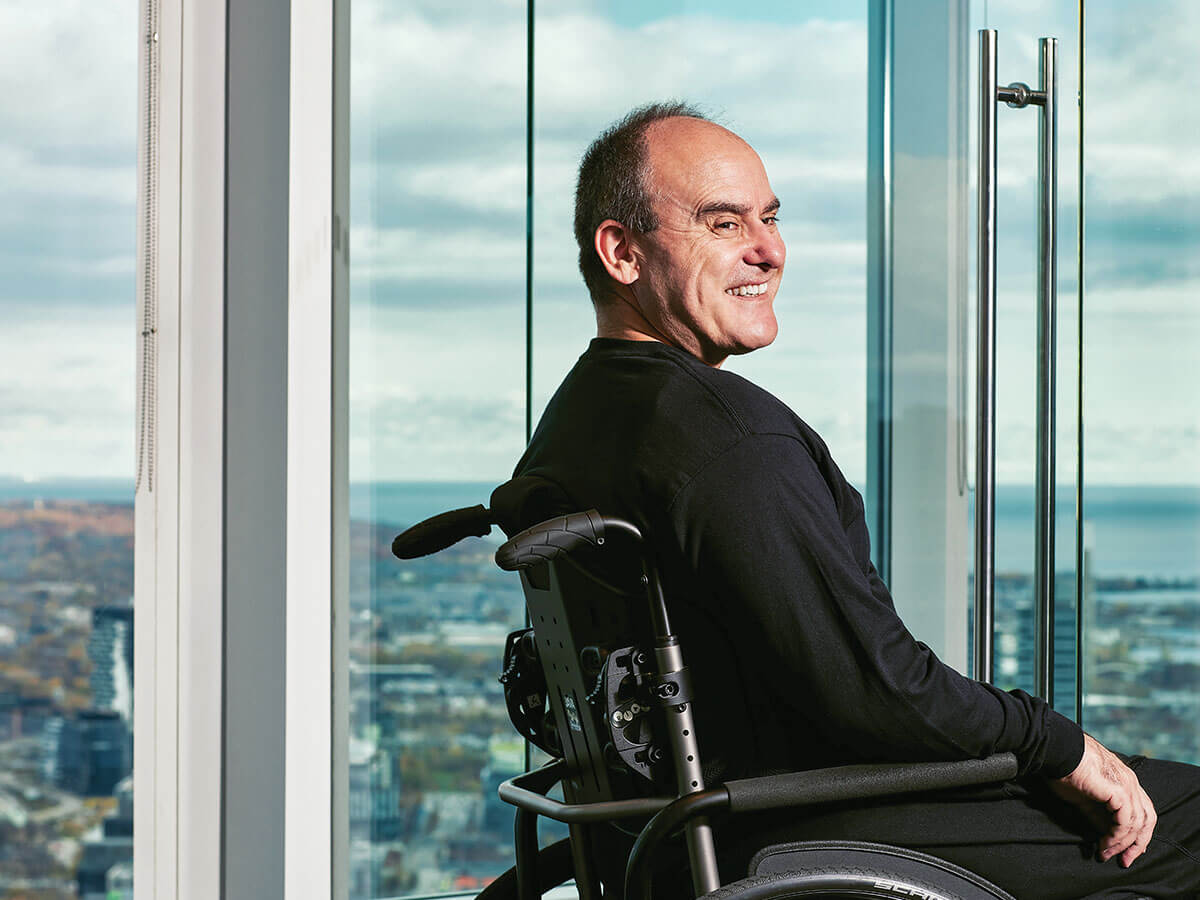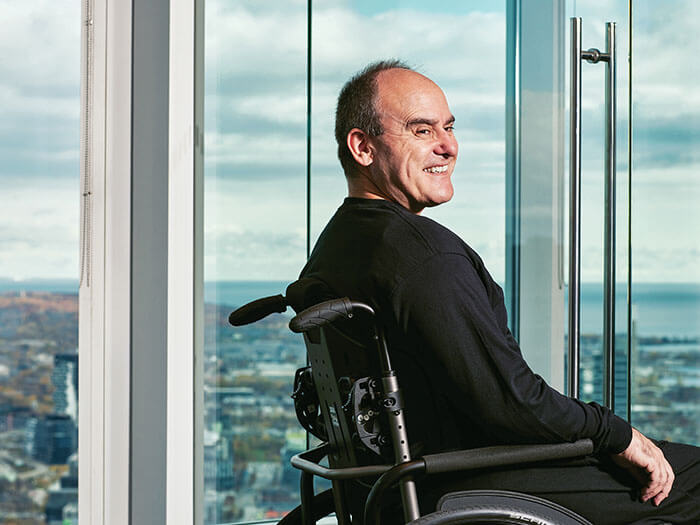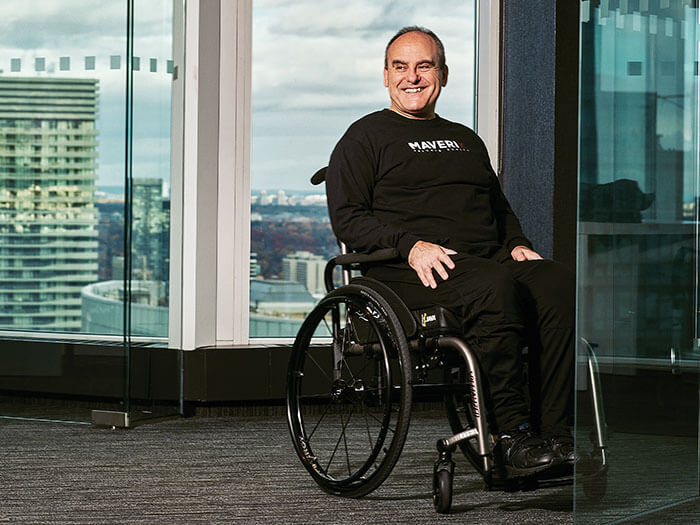
John Ruffolo’s road to recovery
 CPA John Ruffolo is determined to return to the pinnacle of Canada’s venture capital world (Katherine Holland)
CPA John Ruffolo is determined to return to the pinnacle of Canada’s venture capital world (Katherine Holland)
On a wintry afternoon in December 2018, John Ruffolo met his old friend Mark Maybank for a drink in the heart of Toronto’s Financial District. The men, both CPAs and Bay Street veterans, were in a festive mood—the holidays were approaching and Ruffolo was wrapping up a successful eight-year tenure at the helm of OMERS Ventures, the influential investment firm that helped fuel the growth of Shopify, Wattpad and dozens of other startups. But Ruffolo wasn’t there to reminisce about his reign as the behind-the-scenes kingmaker of Canadian tech. He wanted to talk about what would come next.
When Ruffolo founded Ventures in 2011, homegrown entrepreneurs needed a Canadian investor to help them get off the ground. But, by 2018, the country was swimming in venture capital. New companies were sprouting everywhere but, in order to keep growing, they often needed to turn to U.S. investors, forfeiting equity to American institutions. What Canada needed now, the men agreed, was an investment firm that could propel already-budding businesses into the stratosphere—and keep the wealth at home. Over a bottle of white wine, Ruffolo and Maybank vowed to build that firm together.
Six days into the New Year, Ruffolo formalized the vision for Maverix Private Equity in a brief yet bold white paper. He envisioned investing a staggering US$500 million in as many as 10 Canadian companies that were using innovative technology to update archaic industries such as health care, financial services and transportation. Ruffolo would handle top-level strategy and fundraising, while Maybank—who spent five years as president and chief operating officer of Canaccord Genuity, an investment banking firm—would stickhandle the finer details. “It was a perfect pair of complementary skills, coupled with our deep sense of trust and friendship,” says Maybank.
When Ruffolo circulated the white paper, investors practically lined up at his door. The Ontario Teachers’ Pension Plan pledged US$250 million, and a number of smaller backers filled out the fund. “I raised half a billion dollars in 13 days,” says Ruffolo. “It was insane. People didn’t believe it.”
Ruffolo could hardly believe it himself—it seemed too good to be true. In hindsight, it was. That April, Teachers dropped out (the pension plan opted to start its own technology investment program), forcing Ruffolo to rally a slew of new investors. A year later, the firm had retooled and was ready to launch. But then the pandemic hit, upending markets and putting deals everywhere on hold. The universe already seemed to be conspiring against Ruffolo—and the worst was still to come.
On September 2, 2020, Ruffolo, an avid cyclist, set out for a routine long-haul bike ride. From his home in east Toronto, he pedalled east to Rouge Park, then north toward Stouffville along a lightly trafficked rural road. As he racked up the kilometres, he thought through the calls he had to make to finally bring Maverix to fruition.
Just before 1 p.m., Ruffolo heard a truck approaching from behind him. He glanced back to see a hulking white tractor-trailer riding his back tire. The driver allegedly veered over the yellow divider to avoid Ruffolo. Then Ruffolo heard the hiss of the truck’s air brake in his left ear. “Before I could think too much about it, I remember being hit,” he says. The trailer had jack-knifed and slammed into the back of his bike. The impact knocked him unconscious and flung his body 20 feet down the asphalt, where he woke up a moment later. He didn’t know it yet, but his lung had collapsed, several of his ribs were fractured and his pelvis was split open. He felt excruciating pain all over his body—except for his legs, which were frighteningly numb. He immediately realized he’d broken his back.
Crumpled on the road and waiting for an ambulance to arrive, Ruffolo wondered whether he’d survive. The faces of his wife, Carryn, and their two children, Caymus and Rome, flashed through his mind—what would happen to them if he died? He was only 54. To keep himself from spiralling, he pictured doctors examining him in a hospital. “Maybe they’ll fix it,” he told himself.
Finally, sirens sounded in the distance. Paramedics put Ruffolo on a stretcher and began the bumpy drive to Sunnybrook hospital. “I was swearing every two seconds because we were hitting potholes like crazy,” he says. “I felt every single ounce of that pain.” Nearly 30 minutes later, the EMTs wheeled Ruffolo into the hospital. An emergency sign appeared above his head, an oxygen mask descended onto his face and then everything went black.
It was a miracle that he was alive—multiple experts concluded that he shouldn’t have survived the impact
Over the next 48 hours, as Ruffolo slipped in and out of consciousness, Sunnybrook doctors stabilized him and debated what to do about his mangled body. His broken bones and bloody organs were like a Jenga tower—there were so many injuries that fixing one thing could disrupt another. The wrong move could end his life.
On September 4, Ruffolo went under the knife. First, surgeons repaired his split pelvis by bolting it back together. Then, in the next operation, doctors turned their attention to his spinal cord. The accident had shattered his T12, the largest and strongest thoracic vertebra. They began by removing fragments of the pulverized bone, and then they installed rods and screws to stabilize his spinal cord.
When Ruffolo opened his eyes that evening, Carryn was seated at his bedside, overwhelmed with worry. She still didn’t know whether her husband would survive or if he had permanent brain damage. Half-awake and with a tube running down his throat, he scribbled two letters on a piece of paper: C and R, the first initials of their children’s names. Carryn assured her husband the family was fine. It was him they were worried about.
Not long after, when Ruffolo was more lucid, he looked down the length of his bed and couldn’t see his legs. “They cut off my legs!” he thought to himself, making a faint cutting sound to the nurse. She pushed a button that raised the bottom half of his bed. His legs were still there, he just couldn’t feel them.
Doctors later briefed Ruffolo and Carryn on his condition. It was a miracle that he was alive—multiple experts concluded that he shouldn’t have survived the impact. “They don’t understand why I didn’t die,” says Ruffolo. But they said he’d suffered a complete spinal cord injury, which meant that the neural pathways between his brain and his legs were severed. There was no way for his brain to tell his legs to move, nor any way for the nerves in his lower body to send signals up the spinal cord. In other words, he wouldn’t be able to move or feel his legs. They told him he’d never walk again.
Ruffolo and his wife both began to cry, but he immediately refused the prognosis, barking back, “You’re not telling me I’m not going to walk.”
While Ruffolo was convalescing, his network sprang into action. Maybank hired a chef to cook for Carryn and the kids, and he handled Ruffolo’s paperwork—both professional and medical—so she wouldn’t have to. Friends and colleagues called Sunnybrook, asking for information and offering to help in any way they could. Meanwhile, Dr. Eric Hoskins, Ontario’s former health minister and a partner at Maverix, began hunting for someone who could get Ruffolo back on his feet.
The search led Hoskins to Michael Fehlings, a neurosurgeon at Toronto Western Hospital who specializes in spinal cord injuries. He agreed to join Ruffolo’s care team and soon examined his new patient, ordering a series of scans of his spinal cord. Compared to the other doctors, Fehlings was relatively optimistic about Ruffolo’s recovery. He discovered residual neurological function in Ruffolo’s legs—tiny flickers of movement and faint sensations—and imaging revealed that the initial spinal surgery hadn’t removed all the bony debris around his vertebrae. In some ways, that was good news. If Fehlings could remove those fragments through a procedure called decompression, Ruffolo’s neural pathways might have a better chance of rewiring through repetitive physiotherapy. “Many people can have improved outcomes following their injury by removing the pressure off the spinal cord,” says Fehlings. Ruffolo told Fehlings he’d do it if it gave him a one per cent chance of walking again. “What if I offered you fifty-fifty odds?” Fehlings happily replied.
 Ruffolo and his family moved into a new home with an elevator and a home gym. He completes 18 hours of physiotherapy each week. (Katherine Holland)
Ruffolo and his family moved into a new home with an elevator and a home gym. He completes 18 hours of physiotherapy each week. (Katherine Holland)
On October 16, Ruffolo underwent a six-hour surgery. Suspended face-down in a specialized operating table, his back was exposed and Fehlings went to work. First, he removed the rod and screws that were keeping Ruffolo’s spinal column intact. Then he used a diamond drill to cut off pieces of vertebrae, allowing him access to the fragments. Once they were out, he delicately put the pieces back into place, followed by the rods and screws.
The effects of the surgery manifested a few weeks later, when Ruffolo moved into Lyndhurst, a rehabilitation centre in north Toronto. When he strapped into an automatic bike—its pedals pumped Ruffolo’s legs, rather than the other way around—his quads, glutes and hamstrings suddenly sparked to life with a sharp, electric pain. “The muscles that turned on are the cycling muscles,” he says. “It’s like my brain remembered all of my cycling.” He couldn’t move them voluntarily yet, but that was beside the point—he was overjoyed that he could feel his upper legs again. It was proof that he might regain some of the ability that he lost.
Fehlings predicts Ruffolo’s recovery will plateau about 18 months after the accident. It’s hard to say how far he’ll progress by then, but Fehlings says his patient has a few things going for him: he was exceptionally strong before the accident and he’s unflappably positive. “Never once have I heard him complain. Instead, he asks, ‘What can I do?’” says Fehlings. “That’s helped him in his business success and he’s shown a similar tenacity in his determination to achieve the maximum recovery.”
In early November 2020, as the second wave of COVID-19 began to wash over Ontario, Ruffolo was laying in his bed at Lyndhurst. “Everything was locking down and I was bored as hell,” he says. “My mind was racing.” He couldn’t stop thinking about Maverix.
In Ruffolo’s absence, Maybank held the fort, leading the team, managing the day-to-day details of the fund’s imminent launch and fielding alarmed phone calls from investors who’d heard about Ruffolo’s accident. “I was maxed out,” says Maybank. “If you ask me why I’m doing Maverix, it’s shifted since John’s accident. I really wanted to make it happen for him. It was partly professional, but it was also deeply personal.”
“I really do believe that it’s mind over matter. If I imagine it hard enough, it will happen.”
Still bedridden, Ruffolo came back into the fold. Whenever the nurse allowed, he Zoomed into Maverix meetings for 10 minutes at a time. He started calling investors, nonchalantly asking how they were doing and talking about the fund as if nothing had happened. “About halfway through the conversation, they’d say, ‘Hold on, where are you right now?’” he says with a laugh. “I know they all thought I was nuts.”
Crazy or not, Ruffolo was alive—and himself. “It was one thing for me to tell people that John was okay,” says Maybank. “But for John to sound like John on the phone, that calmed a lot of anxiety.”
In April 2021, Maverix officially launched the first segment of its fund, a US$300-million pot of gold with contributions from CIBC, BMO, two pension funds and an A-Team of business titans, including Canada Goose CEO Dani Reiss, Dragons’ Den judge and entrepreneur Arlene Dickinson and a pair of high-profile CPAs, Mattamy Asset Management founder Peter Gilgan and former Research In Motion co-CEO Jim Balsillie. The following month, Ruffolo poached Canadian expat Michael Wasserman, a longtime executive at American investment firm H.I.G. Capital, and brought him back home as a Maverix managing partner. It’s a prime example of what he hopes the firm can do—keep brilliant Canadian brains, and all the wealth and innovation they create, in Canada. Maverix has begun making investment offers but it has not yet publicly finalized any deals.
So far, the fund has made headlines for another reason. Last June, Dr. Chitra Anand, who allegedly worked for Maverix for 18 months, launched a $2.9-million lawsuit against Ruffolo, Wasserman and Maybank, alleging that the firm had never compensated her and fired her unfairly. Anand said she had been hired at a partner level and as part of the founding team with the understanding that she would be paid retroactively once the fund developed.
In a statement of defence, the defendants denied the allegations and claimed that, because Anand’s position was meant to be a learning opportunity, she had signed a confidentiality agreement stating that no remuneration was owed to her. The statement alleged that Anand lacked business competence, displayed disrespect toward others, falsely took credit for others’ work and breached ethical standards by secretly recording a conversation with a colleague. “In the end,” the statement reads, “the defendants had no alternative but to confirm that the plaintiff could not and would not become engaged by Maverix.” Ruffolo, who declined to speak on the record about the lawsuit, referred Pivot to the statement of defence.
Anand, who refutes the points contained in the statement, says that no one had brought up any concerns about her performance until after the launch of the fund. She maintains that Maverix is trying to “rewrite history.” None of the allegations have been proven in court.
Just before the end of 2020, Ruffolo moved back home—his new home, that is. While he was at Lyndhurst, his network of friends and colleagues helped Carryn move the family into a new build down the street from his old place, outfitted with an elevator and a home gym. Ruffolo does three hours of physio a day, six days a week. At a local rehabilitation centre, he practises moving his legs with the help of a harness suspended from the ceiling. “The most painful stuff I do is unlocking my body,” he says, “because it’s used to being in a wheelchair all day long.”
On Zoom calls and in meetings, Ruffolo admits, he puts on a brave face. His energy levels aren’t what they used to be. He naps between appointments and sleeps longer than he used to. “Deep down, he’s as tired as you’d expect,” says Maybank. “He’s pushing his body to the limit. He’s mentally fatigued because he’s dealing with an extensive amount of change.”
Since the accident, Ruffolo has endured bedsores, seven-hour nosebleeds and life-threatening blood clots. For months he was in constant pain—eight or nine out of 10, although lately he says it’s dropped closer to three. “It is really easy to go to a dark place. You can get there without even trying,” he says. “But you look at your family and you say, ‘It doesn’t matter if you feel bad for yourself. What about them?’”
Ruffolo is determined to walk again, even if he needs braces and poles. He’s seen other people do it, so, he figures, why can’t he? He’s already exceeded doctors’ expectations. “I really do believe that it’s mind over matter. If I imagine it hard enough, it will happen,” he says. “It’s just a question of how fast I can get there.”
READ MORE FROM PIVOT
Find out why CPA Jerome Dwight thinks Canada has a big role to play with cryptocurrency trading, see what CPA Janique Lambert is doing to make history at the Office of the Auditor General of Quebec. Plus, read about the global microchip shortage.